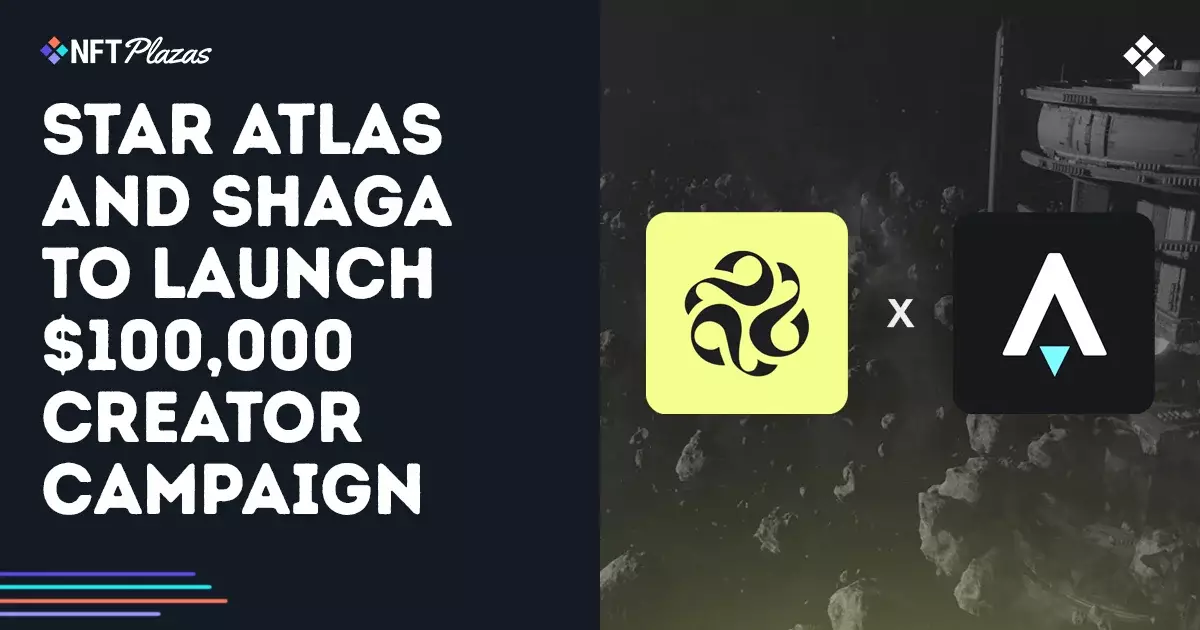In an era where the convergence of technology and creative expression is at its peak, the gaming world has begun to flourish in very dynamic ways. One of the most significant innovations is the emergence of NFT (Non-Fungible Token) gaming, which allows players not only to engage in epic quests but also to invest and exhibit ownership in virtual assets. The latest initiative from the grand strategy MMO Star Atlas, in partnership with Shaga, underscores a monumental leap in community-driven gaming economies—launching a $100,000 Creator Campaign that intertwines viewers, creators, and the allure of digital assets. However, this union, while promising, poses striking challenges that should not be overlooked.
The Allure of Shared Gameplay
At the core of the Star Atlas and Shaga initiative lies an intriguing premise: enabling viewers to take active control during gameplay broadcasts. Creators streaming on Twitch can engage their audience more deeply by allowing them to navigate their gaming environment. This interactive element is a stark departure from traditional one-way streaming, creating a community-centric experience. Yet, while the cubist appeal of shared experience and collective conquest can catapult a creator’s visibility, it can also lead to a dilution of personal branding as creators may find their gaming styles overshadowed by the whims of their audiences.
This creative approach is designed to bolster viewer engagement and creator loyalty, increasing the stakes of the gameplay. However, it raises questions about the authenticity of individual skills. Can creators maintain their identity when gameplay is predominantly influenced by their audience, whose actions might not reflect their own style or strategy? The risk of alienating viewers who crave unique and stylized play could ultimately undermine the campaign’s intent and creator reputation.
$100,000 in Digital Bounty: Incentives and Implications
The campaign’s substantial prize pool of $100,000 itself serves as a magnetic call to action for content creators, signaling a financial investment in cultivating community. Enabling creators to earn rewards in $ATLAS tokens, exclusive ship NFTs, and Shaga’s GLOB points certainly adds layers of financial incentive—turning gaming into a potentially profitable endeavor. However, this model could distort content creation into a mere transactional relationship, where genuine enthusiasm for gaming might take a back seat to profit motives.
Furthermore, creators might feel pressured to curate content that prioritizes engagement metrics over authentic gameplay artistry, which could compromise their creative integrity. The gaming community thrives on innovation, but a focus on profit can lead to homogenized content and uninspired creativity.
The Role of Technology in Creative Expression
The technological underpinnings of Shaga, a cooperative cloud gaming platform, are notably appealing. By allowing creators with capable gaming rigs to host and stream while rewarding them, Shaga democratizes access to evolving gaming experiences for anyone with a smartphone. Yet, this intriguing model also presents a potential paradox—accessibility may surreptitiously encroach upon the uniqueness of creator-driven content.
The ultra-low latency technology employed by Shaga enhances interactivity but also requires creators to consistently engage within a set framework, stunting creative spontaneity. A shift towards standardized forms of engagement is often a consequence when creators strictly follow technological trajectories imposed by audience interaction. Such developments create a tension between artistic expression and the tools employed—pushing the boundaries of what it means to be a creator in virtual realms.
The Future of NFT Gaming: Risks Ahead
As we navigate the monumental pressures of integrating digital assets and massive engagement strategies, one cannot ignore the pitfalls inherent to NFT gaming. The volatility of cryptocurrency markets, the potential for exploitative practices, and a rapidly evolving technological landscape all pose substantial risks. With current estimates putting the $ATLAS market cap at over $22.6 million, creators must remain vigilant against the whims of market fluctuations—possible crashes could leave committed creators in the lurch, undermining the long-term viability of the investments made into their digital ecosystem.
Moreover, the partnership with decentralized AI networks to incorporate agents into the game hints at a bright future for immersive gameplay. However, as technological sophistication increases, so does the risk of reliance on algorithms that may dehumanize interactions, reducing the creative vibrancy that has long defined gaming. This imbalance could affect community dynamics, leading to disengagement and a sense of alienation among gamers who value connection over algorithmic processes.
In drawing these threads together, the Star Atlas and Shaga Creator Campaign offers both exhilarating potential and precarious peril. As creators and audiences embark together on this journey through digital realms, a conscious balance between financial motivations, technological aids, and genuine creative expression must be maintained if this endeavor is to thrive. Ultimately, the success of this campaign may well serve as a litmus test for the future of NFT gaming altogether.
















Leave a Reply